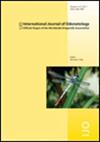Dragonfly flight: a Symposium from the 2017 International Congress of Odonatology held at Clare College, Cambridge
IF 1
4区 农林科学
Q3 ENTOMOLOGY
引用次数: 0
Abstract
At the 2017 International Congress of Odonatology the opportunity was taken to present a half day symposium on dragonfly flight. This symposium was organised to honour the fundamental contributions to investigations into insect flight made over more than three decades by Charles Ellington, at a Congress being held at his home institution. We were honoured that Charlie was able to attend our Symposium. Because of a gentleman’s agreement with Robin Wootton, dividing up the tasks to be done, Charlie did little direct work on dragonflies. However, his work, especially on unsteady state aerodynamics, has had enormous influence on directing researchers. While he did not publish on dragonflies he did think about them a lot and has always been ready to comment and counsel. In terms of insect flight the four independently controlled wings of dragonflies provides both incredible manoeuvrability and power for the animal, and a supreme test of our capacity for analysis and understanding. Dragonflies can achieve accelerations of greater than 10g, and up to 20g in some interpretations, linearly as well as in turns. They can brake to a stop within a few wing strokes; two wing strokes can effect a 180° turn, with the animal spinning about its centre of mass. They can hover, with body horizontal. They can fly backwards. They can tumble. They can side-slip, whether climbing, maintaining altitude or diving. And in all these activities they seemingly remain in total control. In the Symposium the following papers were presented (for multi-authored presentations the presenter’s names are underlined):蜻蜓飞行:2017年在剑桥克莱尔学院举行的国际口腔病学大会研讨会
在2017年国际蜻蜓学大会上,有机会举办了为期半天的蜻蜓飞行研讨会。组织这次研讨会是为了表彰查尔斯·艾灵顿在其家乡机构举行的一次大会上对昆虫飞行调查三十多年做出的基本贡献。我们很荣幸查理能够参加我们的研讨会。由于与罗宾·伍顿达成了君子协定,将要完成的任务分开,查理几乎没有直接研究蜻蜓。然而,他的工作,特别是在非稳态空气动力学方面,对指导研究人员产生了巨大的影响。虽然他没有发表关于蜻蜓的文章,但他确实考虑了很多,并随时准备发表评论和建议。在昆虫飞行方面,蜻蜓的四个独立控制的翅膀为动物提供了令人难以置信的机动性和力量,也是对我们分析和理解能力的最高考验。蜻蜓可以实现大于10克的加速度,在某些解释中可以达到20克,线性和转弯。它们可以在几次机翼冲程内刹车停止;两翼划动可以实现180°转弯,动物围绕质心旋转。它们可以悬停,身体水平。它们可以向后飞。它们可以翻滚。无论是攀登、保持高度还是潜水,它们都可以侧滑。在所有这些活动中,他们似乎仍处于完全的控制之下。在研讨会上,发表了以下论文(对于多人撰写的论文,演讲者的姓名加下划线):
本文章由计算机程序翻译,如有差异,请以英文原文为准。
求助全文
约1分钟内获得全文
求助全文
来源期刊

International Journal of Odonatology
ENTOMOLOGY-
CiteScore
2.30
自引率
0.00%
发文量
15
审稿时长
>12 weeks
期刊介绍:
International Journal of Odonatology (IJO) is aimed at providing a publication outlet for the growing number of students of Odonata. It will address subjects such as the ecology, ethology, physiology, genetics, taxonomy, phylogeny and geographic distribution of species. Reviews will be by invitation, but authors who plan to write a review on a subject of interest to the journal are encouraged to contact the editor.
 求助内容:
求助内容: 应助结果提醒方式:
应助结果提醒方式:


